| | 

| 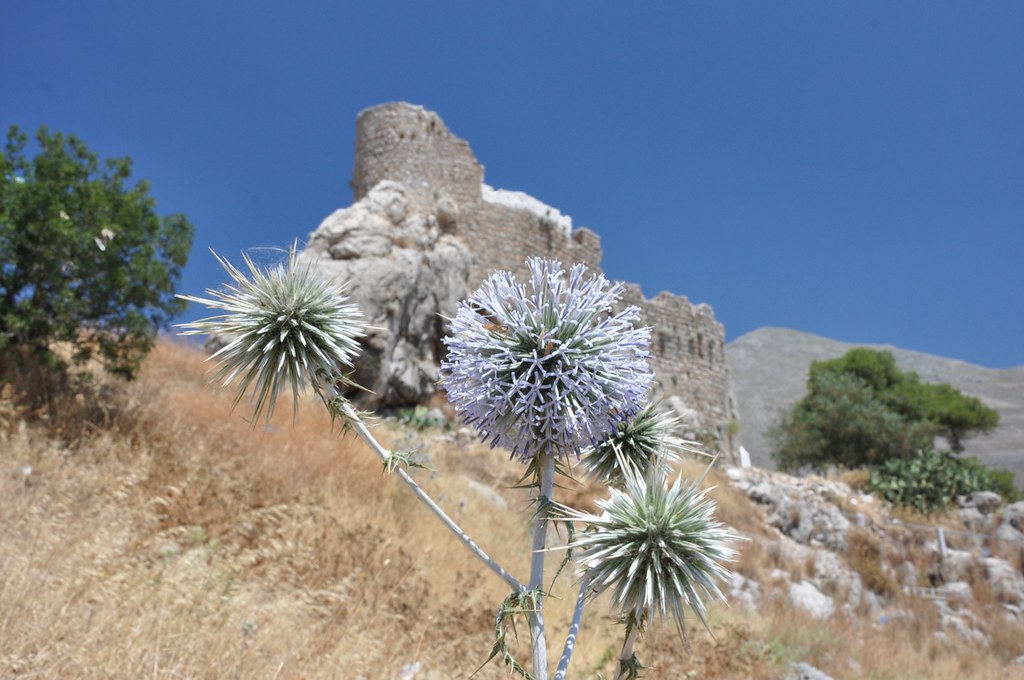
"The Dodecanese Campaign of World War II was an attempt by Allied forces, mostly British, to capture the Italian-held Dodecanese islands in the Aegean Sea . . . The Allied effort failed, with the whole of the Dodecanese falling to the Germans within two months, and the Allies suffering heavy losses in men and ships"
The confusion surrounding the surrender of Italy, seizing those islands struck Churchill as easy pickings, as a vast potential for future Allied operations. A single British brigade, the 234th, began a bold island hopping campaign. In time, the Germans countered and checked the advance, first at the island of Kos, and then later at Leros. The war in the Aegean highlighted a clash of weapons systems, with the Luftwaffe controlling the air while the Royal Navy dominated the seas. | |
| 
The Dodecanese islands of Rhodes, Kos, Leros and Samos.
Players: Allies: 234th Brigade, 74 Squadron RAF and 7 Squadron Royal South African Air Force; Long Range Desert Group; Special Boat Section. Overall commander in Middle East Command, General Henry Maitland Wilson. Axis: Italian garrisons commanded by Admiral Inigo Campioni; German 22nd Infantry Division and Brandenburg Regiment.
Outcome: These Italian-held islands were taken by Germany despite Allied intervention. "The failed campaign, and in particular the Battle of Leros, inspired the 1957 novel 'The Guns of Navarone' and the successful 1961 movie of the same name." Here with the Dodecanese Campaign [1943] from the Second World War [WW2].
The "Twelve Islands" of the Aegean, occupied primarily by Italian troops whose fighting capacity was deemed as totally lacking. The campaign seen by planners as an opportunity that offered advantage.
Almost exclusively a British operation, badly gone awry.
A decisive German victory [the last major German victory of the war], a decisive English defeat [the last major British defeat of the war]!
An attempt at Balkan machinations by Churchill. An attempt to bring Turkey into the war on the side of the allies. An attempt to use the airfields of the Dodecanese as bases from which the oil fields of Romania [Ploesti] could be bombed.
NOTHING going according to plan. English efforts resulting in significant loss for allied forces, German troops perpetrating some atrocity at the behest of Hitler!
"The United States were skeptical about the operation, which they regarded as aiming mostly at post-war political benefits for Britain, andan unnecessary diversion from the main front in Italy. They refused to support it, warning the British that they would have to go on alone"
Once again - - almost exclusively a British military adventure, against the wishes of Eisenhower!
"With Mussolini's government gone, Winston Churchill wished to take control of these islands as bomber bases to attack Adolf Hitler's oil fields in Romania. His plans were opposed by American General Dwight Eisenhower based on his suspicion of British imperialistic ambitions as well as Eisenhower's favor for a direct confrontation with German forces in Western Europe. Churchill proceeded with his own plans to align the Dodecanese Islands with the Allies despite Eisenhower's decision that he could only spare some air cover for Churchill's detachments." Italy took the Dodecanese islands in 1940, during its ill-fated invasion of Greece. Following the removal of Mussolini in July 1943, Churchill proposed that the Allies 'turn' the Italian governors of the islands, thus gaining control of the Dodecanese and opening a sea route to the Soviet Union. Eisenhower, suspicious of British imperial ambitions and preferring to concentrate Allied effort on the Italian mainland, resisted the proposal. A planned invasion of Rhodes - codenamed Operation Accolade - was called off; troops and equipment earmarked for the operation were transferred to Italy, France and India. After Italy's surrender on 8 September, General Henry Wilson contacted the Italian Admiral Inigo Campioni on Rhodes and urged him to hold out until the 15th, when British troops could be supplied. Campioni surrendered to the Germans on 11 September. Wilson then contacted the Italian governors of Kos, Leros and Samos, all of whom agreed to take British reinforcements: paratroops, Special Boat Squadron units and squadrons of the RAF and South African Air Force (SAAF). However, the Germans' occupation of Rhodes gave them effective air superiority; by October the RAF and SAAF forces were beaten. Deprived of air cover, the islands could not resist for long. Kos fell to the Germans on 4 October; Leros fell, after prolonged bombardment, on 16 November; Samos, finally, was evacuated on 20 November. Whether it was a promising initiative or a quixotic diversion, the Dodecanese campaign was doomed from the outset by under-resourcing and Allied disagreements. | 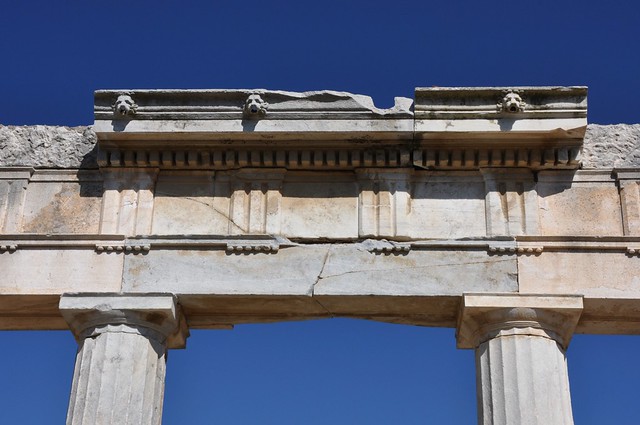
Western Archaeological Site Ruins of the ancient Gymnasium in Kos.The remains of the ancient city of Kos are scattered throughout the town of Kos and are divided into three archaeological zones: the central, the eastern and the western. Western Archaeological Site include the remains of Hellenistic and Roman buildings of which Nymphaeum and Gymnasium are the most impressive monuments of the Kos ancient past. Xysto, located in the Western Archaeological Site close to the centre of the town, is the remains of the largest gymnasium on Kos, built in the 3rd century B.C.
The name Xysto is derived from the fact that athlestes screpped ('xisoun') their bodies in order to remove the oil, which they anointed themselves with, before training and competing.
The building contains 17 restored columns of white marble in the Doric style, out of the original 81 that formed the colonnades of the structure. The gymnasium was decorated with lion heads, examples of which can still be seen. In the middle of the gymnasium was a water cistern, where athletes could wash themselvesduring training. The Nymphaeum was adjacent to the Xysto, so the athletes could also bathe and relax after training. -
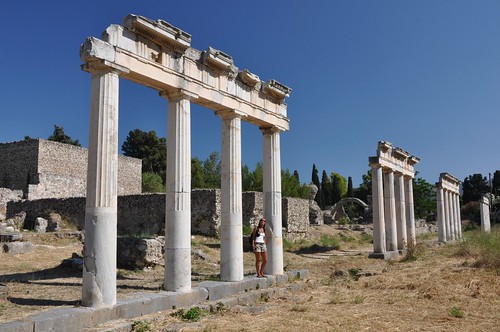
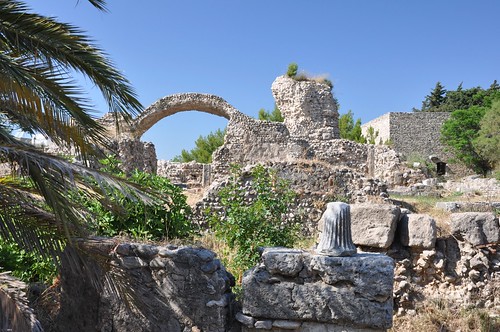
Nymphaeum (3rd century) was a Roman public bathhouse, ringed by white marble columns and containing some fine mosaic floors. Here you will see an almost intact calidarium (hot room) with a pool, whilst frigidarium (cold room) and pool have been partly absorbed into the adjoining Christian basilica.
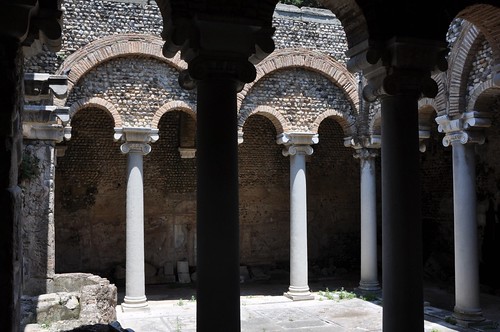 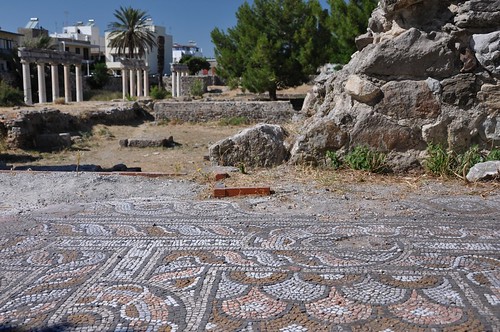
The marble paved Roman cardo (main street) runs through the site and the restored colonnades gives a real feel of how splendid this part of the ancient city must have been two millennia ago.
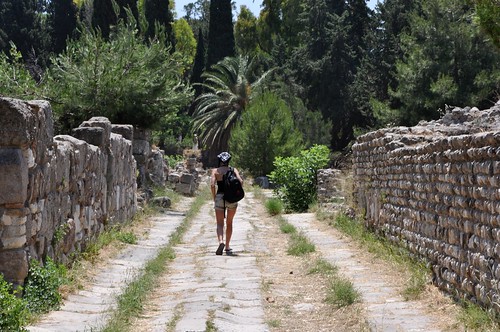 -
★ elinor04 than 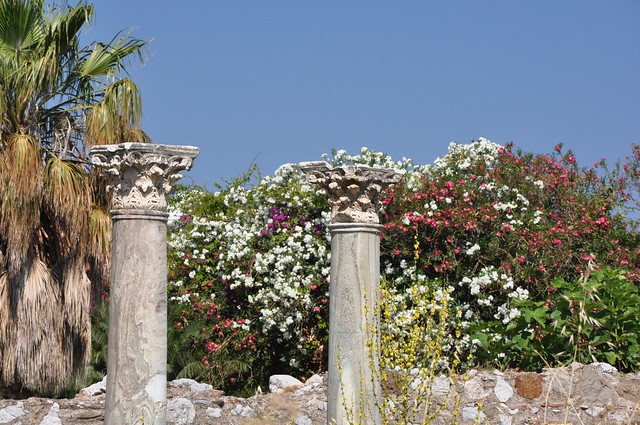
The Limenos Basilica The ruins of the so-called Limenos Basilica, a Christian church dating from the 5th century, standing in the Kos Agora.
It was a three-naved basilica with a wooden roof, and an atrium and baptistery. With the length of 72 metres and width of 23 metres it was one of the biggest basilicas in the Mediterranean at the time it was built. Most likely the church was the first building of the new religion in Kos. The Basilica was erected on the remnants of the Limenos Arcade and the embakment of the eastern harbour, with the extensive use of the building materials coming from the numerous ancient structures standing around the Agora. Ironically, one thousand years later, the basilica itself served as a source of the building material during the extension of the Neratiza Castle by the Knights Hospitaller. 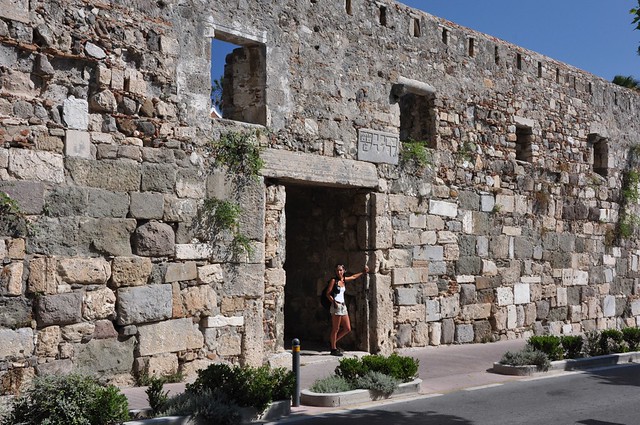
Town of the Knights The southern gate in the city walls of Kos, which were built in the years 1391-1396 by the Knights Hospitaller for the defense of the town. Over the gate the three coats of arms embedded in the wall still can be seen; they are (from left to right): the coat of arms of Juan Fernando Heredia (the Grandmaster of the Order in the years 1377-1396), the coat of arms of the Order of St John, and the coat of arms of a German knight and architect Heinrich Schlegelholt. After the fall of the Kingdom of Jerusalem in 1291, the Knights Hospitallers (The Sovereign Military Hospitaller Order of St. John of Jerusalem) were confined to the County of Tripoli and, when Acre was captured in 1291, the order sought refuge in the Kingdom of Cyprus. Finding themselves becoming enmeshed in Cypriot politics, their Grand Master, Guillaume de Villaret, created a plan of acquiring their own temporal domain, selecting Rhodes to be their new home. His successor, Fulkes de Villaret, executed the plan, and in 1309, after over two years of campaigning, the island of Rhodes surrendered to the knights. They also gained control of a number of neighboring islands of Dodecanese, including the island of Kos - which quickly became a strong fortress in the sovereign state of the Order. The Knight Hospitallers grew stronger on Rhodes. They had received some benefit from the dissolution of the Knights Templars, and the wealth of their grand priories all over Europe had greatly increased. To some extent, at least, the change was accompanied by a decline in moral standards. The Knights of Rhodes, as they came to be known, maintained their reputation as fighting men.
In 1344 the knights, with the Genoese, retook Smyrna and held it for a short time. In 1365, in conjunction with the king of Cyprus, they captured Alexandria, which, however, they were unable to retain.
The island of Rhodes was an important strategic point, and the Turks on their advance after the capture of Constantinople determined to take it. A heroic episode in medieval military history was the successful defense of Rhodes by the Grand Master Pierre d'Aubusson, against the forces sent by Sultan Muhammad II. But the knights could not summon the means to resist indefinitely, and in 1522 the Grand Master Philippe de L'Isle Adam was forced to capitulate. The Knights left Rhodes and their other strongholds in the region, including Kos, in 1523.  | | The Dodecanese Campaign of World War II was an attempt by Allied forces, mostly British, to capture the Italian-held Dodecanese islands in the Aegean Sea following the surrender of Italy in September 1943, and use them as bases against the German-controlled Balkans. The Allied effort failed, with the whole of the Dodecanese falling to the Germans within two months, and the Allies suffering heavy losses in men and ships.[3] The operations in the Dodecanese, lasting from 8 September to 22 November 1943, resulted in one of the last major German victories in the war.[4] The Dodecanese island group lies in the south-eastern Aegean Sea, and had been under Italian occupation since the Italo-Turkish War. During Italian rule, the strategically well-placed islands became a focus of Italian colonial ambitions in the Eastern Mediterranean. Rhodes, the largest of the islands, was a major military and aerial base. The island of Leros, with its excellent deep-water port of Lakki (Portolago), was transformed into a heavily fortified aeronautical base, "the Corregidor of the Mediterranean", as Mussolini boasted. After the fall of Greece in April 1941 and the Allied loss of the island of Crete in May, Greece and its many islands were occupied by German and Italian forces. With the ultimate defeat of Axis forces in North Africa in spring 1943, Winston Churchill, who at least as far back as the Gallipoli Campaign had a deep interest in the region, turned his sights on the islands. The British envisaged an operation to capture the Dodecanese and Crete, and thus not only deprive the Axis of excellent forward bases in the Mediterranean, but also apply pressure on neutral Turkey to join the war. This would serve a favourite idea of Churchill's, of a "route through the Dardanelles to Russia as an alternative to the Arctic Convoys."[5] In the Casablanca Conference, the initial go-ahead was given, and Churchill ordered his commanders to lay out relevant plans on 27 January 1943. The plans, codenamed "Operation Accolade", called for a direct attack on Rhodes and Karpathos, with forces totaling three infantry divisions, an armoured brigade, and relevant support units. Landings at Crete, which was too well fortified and had a strong German garrison, were dropped. The main problem faced by the planners was the difficulty of countering the 10th Flying Corps (X Fliegerkorps) of the German Air Force (Luftwaffe) because of a lack of air cover, since the American and British aircraft were based in Cyprus and the Middle East. This challenge was further exacerbated by the demands of the upcominginvasion of Sicily. The Americans were skeptical about the operation, which they regarded as aiming mostly at post-war political benefits for Britain, and an unnecessary diversion from the main front in Italy. They refused to support it, warning the British that they would have to go on alone.[7] As an Italian surrender became increasingly possible, in August 1943 the British started preparations to take quickly advantage of a possible Italian-German split, in the form of a scaled-down "Accolade". A force based on 8th Indian Division started being assembled, and American assistance in the form of P-38 Lightning long-range fighter squadrons was requested. As a result of the Quebec Conference however, and the American refusal to assent to the British plans, the forces and ships earmarked for "Accolade" were diverted to other fronts, barely a week before the surrender of Italy on 8 September.[8] [edit]Initial Allied and German moves — The Fall of Rhodes On the announcement of the Armistice, the Italian garrisons on most of the Dodecanese Islands either wanted to change sides and fight with the Allies or just return to their homes. However, in anticipation of the Italian surrender, German forces, based largely in mainland Greece, had been rushed to many of the islands to gain control. The German forces were part of Army Group E commanded by Luftwaffe GeneralAlexander Löhr. The most important German force in the Dodecanese was the 7,500-strong Assault Division "Rhodes" (Sturm-Division Rhodos) commanded by Generalleutnant Ulrich Kleemann. This division had been formed during the summer in the island of Rhodes, which was the administrative center of the Dodecanese Islands and possessed three military airfields. Because of this, Rhodes was the principal military objective for both the Allies and the Germans. On 8 September, the Italian garrison on the island of Kastelorizo surrendered to a British detachment, which was reinforced during the following days by ships of the Allied navies. The next day a British delegation, headed by Lord Jellicoe, was dropped by parachute on Rhodes, in order to persuade the Italian commander, Admiral Inigo Campioni, to join the Allies. The swift action of the German forces, however, preempted the Allies. Without waiting for the Italians to decide, Kleemann attacked the 40,000-strong Italian garrison on 9 September, and forced it to surrender by 11 September. The loss of Rhodes dealt a heavy and critical blow to Allied hopes. While the government of the Kingdom of Italy surrendered and many Italian soldiers in the Aegean were tired of the war and had become opposed to Mussolini, Italian Fascist loyalists remained allied to Germany in the Greek campaign, with General Mario Soldarelli rallying Fascist Blackshirts and Italian soldiers loyal to Mussolini to continue the war in support of Mussolini's aims, and German forces in Greece convinced 10,000 Italians in the Aegean to continue to support their war effort.[10] Despite this setback, however, the British High Command pressed ahead with the occupation of the other islands, especially the three larger ones, Kos, Samos and Leros. The Germans were known to be overstretched in the Aegean, while the Allies enjoyed definite superiority at sea and the air cover provided by two Spitfire squadrons (7 Squadron, SAAF and 74 Squadron, RAF) at Kos was deemed sufficient.[11] It was hoped that from these islands, with Italian cooperation, an assault against Rhodes could be eventually launched.[12] Thus, from 10 to 17 September, the British 234th Infantry Brigade under Major General F. G. R. Brittorous coming from Malta, together with 160 men from the SBS, 130 men from the LRDG, A Company, 11th Bn, Parachute Regiment[13] and Greek Sacred Band detachments had secured the islands of Kos, Kalymnos, Samos, Leros, Symi and Astypalaia, supported by ships of the British and Greek navies. The Germans quickly mobilized in response. By 19 September, Karpathos, Kasos and the Italian-occupied islands of the Sporades and the Cyclades were in German hands. On 23 September, Lieutenant-General Friedrich-Wilhelm Müller was ordered to take Kos and Leros. Müller was the commander of the22nd Infantry Division garrisoning "Fortress Crete". Battle of Kos Having identified the vital role of the Allies' only airfield at Kos, X Fliegerkorps started carrying out bombing raids on it and the Allied positions of the island, from 18 September. At the same time, reinforcements in aircraft started arriving, giving the Germans 362 operational aircraft in the area of the Aegean by 1 October.[15] The British forces on Kos numbered about 1,500 men, 680 of whom where from the 1st Bn, Durham Light Infantry, the rest being mainly RAF personnel, and ca. 3,500 Italians of the 10th Regiment of the 50th "Regina" Infantry Division. On 3 October, the Germans effected amphibious and airborne landings known as Operation Eisbär ("Polar Bear") and reached the outskirts of the island's capital later that day. The British withdrew under cover of night. They surrendered the next day. The fall of Kos was a major blow to the Allies, since it deprived them of vital air cover.[16] The Germans captured 1388 British and 3145 Italian prisoners.[17] On 3 October, German troops executed the captured Italian commander of the island, Colonel Felice Leggio, and one-hundred-and-one of his officers. This was done in accordance with Adolf Hitler's order of 11 September to execute captured Italian officers.[18] Battle of Leros In the aftermath of the fall of Kos, the Italian garrison of Kalymnos surrendered, providing the Germans with a valuable base for operations against their next target, Leros. The operation, codenamed OperationLeopard, was originally scheduled for 9 October, but on 7 October, the Royal Navy intercepted and destroyed the German convoy headed for Kos. In addition to the loss of several hundred men, the Germans also lost most of their few heavy landing craft. The Germans were forced to bring in new ones by rail, and it was not until 5 November that they had assembled a fleet of twenty-four such light infantry landing craft. To avoid interception by the Allied navies, they were dispersed among several Aegean islands and camouflaged. Despite Allied efforts to locate and sink the invasion fleet, as well as repeated shelling of the ports of German-held islands (see naval operations section below), the Germans suffered little losses and were able to assemble their invasion force, under Generalleutnant Müller, for Operation Taifun ("Typhoon") on 12 November. The German invasion force consisted of personnel from all branches of the Wehrmacht, including veterans from the 22nd Infantry Division, a Fallschirmjäger (paratroop) battalion, and an amphibious operations company (coastal raider, Küstenjäger) from the Brandenburger special operation units. The Allied garrison of Leros consisted of most of the 234th Infantry Brigade, ca. 3,000 men of the 2nd Bn, The Royal Irish Fusiliers, under Lieutenant Colonel Maurice French, the 4th Bn, The Buffs (The Royal East Kent Regiment), the 1st Bn, The King's Own Royal Regiment (Lancaster), and the 2nd company of the 2nd Bn, Queen's Own Royal West Kent Regiment, under Brigadier Robert Tilney, who assumed command on 5 November. There were also ca. 8,500 regular Italian soldiers, mostly naval personnel, under Admiral Luigi Mascherpa. Leros had been subjected by the Luftwaffe to a prolonged aerial bombardment, starting on 26 September, which had already caused significant casualties and damage, both among the defenders of the island and amongst the supporting naval forces. In the early hours of 12 November, the invasion force in two groups approached the island from east and west. Despite failures in some areas, the Germans established a bridgehead, while airborne forces landed on Mt. Rachi, in the middle of the island. After repulsing the Allied counterattacks and being reinforced the following night, the Germans quickly cut the island in two and the Allies surrendered on 16 November. The Germans suffered 520 casualties and captured 3,200 British and 5,350 Italian soldiers.[19] Naval operations Since the operational theater was dominated by a multitude of islands and the Allies and Germans had to rely on naval vessels for reinforcements and supplies, the naval component of the campaign was especially pronounced. Initially naval presence on both sides was low, most of the Allied shipping and warships had been transferred to the central Mediterranean, in support of the operations in Italy, while the Germans did not have a large naval force in the Aegean. The Germans had air superiority, which caused the Allies many losses in ships. Vice Admiral Werner Lange, German Naval Commander-in-Chief of the Aegean, tried to reinforce the isolated German garrisons and carry out operations against Allied garrisons, while transporting the Italianprisoners of war to the mainland. Allied ships tried to intercept these, resulting in several tragic losses. On 23 September, HMS Eclipse sank the torpedo-boat TA 10 and the steamer Donizetti, which had 1,576 Italian captives on board.[9] Another tragedy occurred a month later, when USAAF B-25s and RAF Beaufighters sank the cargo ship Sinfra, which had 2,389 Italian POWs, 71 Greek POWs and 204 German guards on board, of whom only 539 were saved.[17] On 14 September the first Allied loss occurred, when RHN Katsonis, was rammed and sunk by U-boat hunter UJ 2101. The Luftwaffe also intervened in force: On 26 September, 25 Junkers 88 sank the RHNVasilissa Olga and the HMS Intrepid at Lakki Bay, Leros, followed on 1 October by the Italian Euro and HMS Panther and Carlisle (heavily damaged) on 9 October. At the same time, the short range of Hunt class destroyers HMS Aldenham and RHN Pindos and RHN Themistoklis prevented them from intercepting the German invasion convoy headed for Kos.[17] Further losses on both sides followed; after the loss of Kos and friendly air cover, the Allied navies concentrated on supply missions to the threatened islands of Leros and Samos, mostly under the cover of night. On 22–24 October, a German minefield east of Kalymnos caused the sinking of HMS Hurworth and HMS Eclipse, while RHN Adrias lost its prow; the ship managed to escape to the Turkish coast and after makeshift repairs, sailed to Alexandria. 
On the night of 10–11 November, a group consisting of the destroyers HMS Petard, HMS Rockwood and ORP Krakowiak bombarded Kalymnos and HMS Faulknor Kos, where German forces were assembling for the attack on Leros. Nonetheless, the German convoy reached Leros on 12 November, escorted by over 25 ships, mostly U-boat hunters, torpedo boats and mine sweepers. During the subsequent nights, Allied destroyers tried to find and destroy the German vessels without success, limiting themselves to bombarding the German positions on Leros. With the fall of Leros on 16 November, the Allied ships were withdrawn, evacuating the remaining British garrisons.[19] By that time, the Germans had also started employing the Do-217s of KG.100, with their novel Henschel Hs 293 radio-controlled missile, scoring two hits: causing severe damage to HMS Rockwood on 11 November and sinking HMS Dulverton two days later.[19] The Allies lost six destroyers sunk and two cruisers and two destroyers damaged, between 7 September and 28 November 1943.[3] Aftermath After the fall of Leros, Samos and the other smaller islands were evacuated. The Germans bombed Samos with Stukas (I. Group Stuka Wing 3 in Megara), prompting the 2,500-strong Italian garrison to surrender on 22 November. Along with the occupation of the smaller islands of Patmos, Fournoi and Ikaria on 18 November, the Germans thus completed their conquest of the Dodecanese, which they were to continue to hold until the end of the war. The Dodecanese Campaign is one of the last great defeats of the British Army in World War II, and one of the last German victories. The German victory was predominantly due to their possession of complete air superiority, which caused great losses to the Allies, especially in ships, and enabled the Germans to supply and support their forces. The operation was criticized by many at the time as another useless Gallipoli-like disaster and laid the blame at Churchill's door; perhaps unfairly so, since he had pushed for these efforts to be made far sooner, before the Germans were prepared. In the context of the Holocaust, the British failure to capture the Dodecanese sealed the fate of the Jews living there. Although Italy had passed the anti-Jewish law of the Manifesto of Race in 1938, Jews living on the Dodecanese islands (and Italian-occupied Greece) experienced much less antisemitism than in the German and Bulgarian occupied zones of Greece, where harsher and harsher policies were implemented over time against the Jews, culminating in March 1943 with deportations to the death camps in occupied Poland. The Italian surrender, the subsequent German takeover and the failure of the Allied offensive meant that the safe haven disappeared and most of the Dodecanese Jews were eventually murdered by the Germans. In particular, 1,700 members of the ancient Jewish community of Rhodes (of a population of about 2000) were rounded up by the Gestapo in July 1944 and only some 160 of them survived the camps.[20][21][22][23] The Italian prisoners of war were transferred to the mainland by the Germans in overcrowded unseaworthy vessels, which led to several accidents, of which the sinking of the SS Oria on February 12, 1944 was the most deadly. More than 4,000 Italians died when the ship sank in a storm. | The Guns of Navarone is a 1961 British-American Action/Adventure war film directed by J. Lee Thompson and based on Alistair MacLean's 1957 novel The Guns of Navarone about the Dodecanese Campaign of World War II. It stars Gregory Peck, James Robertson Justice, David Niven and Anthony Quinn, along with Anthony Quayle, and Stanley Baker. The book and the film share the same basic plot: the efforts of an Allied commando team to destroy a seemingly impregnable German fortress that threatens Allied naval ships in the Aegean Sea, and prevents 2,000 isolated British troops from being rescued. Contents In 1943, the Axis powers decide that a show of strength might bully neutral Turkey into joining them. Their target is 2,000 British soldiers marooned on the island of Kheros in the Aegean Sea. Rescue by the Royal Navy is impossible because of massive radar-directed guns on the nearby island of Navarone. Time is short, because the Germans are expected to launch an assault on the British forces. Efforts to destroy the guns by aerial bombing have proved fruitless. So that six destroyers can pick up the stranded men, Commodore Jensen (James Robertson Justice) of Allied Intelligence gathers a team of commandos to sail to Navarone and destroy the guns. Led by Major Roy Franklin (Anthony Quayle), they are Captain Keith Mallory (Gregory Peck), renowned mountaineer; Colonel Andrea Stavrou (Anthony Quinn), from the defeated Greek army; Franklin's best friend Corporal Miller (David Niven), a former University Chemistry teacher and explosives expert; Greek-American Spyros Pappadimos (James Darren), a native of Navarone; and "Butcher" Brown (Stanley Baker), an engineer and expert knife fighter. Disguised as Greek fishermen on a decrepit boat, they sail across the Aegean Sea. They are intercepted by a German boat and boarded. They attack and kill all the Germans and sink the patrol boat. During the remainder of the voyage, Mallory confides to Franklin that Andrea has sworn to kill him after the war, because he was inadvertently responsible for the deaths of Andrea's wife and children. In a violent storm, the ship is wrecked and they lose part of their equipment but still manage to land on the island. Led by Mallory, who was recruited for his climbing skills, they scale the "unclimbable" cliff. But Franklin is badly injured; the injury later becoming infected with gangrene. They find that the cliff is, in fact, guarded after all. Miller suggests that they leave Franklin to be "well cared for" by the enemy. Mallory, who assumes command of the mission, feels that Franklin would be forced to reveal their plans, so he orders two men to carry the injured man on a stretcher. Franklin tries to commit suicide, but Mallory lies to him, saying that their mission has been "scrubbed" and that a major naval attack will be mounted on the side of the island opposite the gun emplacement. They rendezvous with local resistance fighters, Spyros's sister Maria (Irene Papas) and her friend Anna (Gia Scala), who was captured, tortured, and escaped. She was so traumatized that she cannot speak and will not allow even Maria to see her scars. The mission is continually dogged by German soldiers, and the group is captured by Oberleutnant Muesel (Walter Gotell) in the town of Mandrakos, when they try to find a doctor for Franklin. Muesel and Hauptsturmführer Sessler (George Mikell) of the SS fail to persuade the saboteurs to tell them where Miller's explosives are. Andrea pretends to grovel and beg for mercy, which surprises the Germans, allowing the group to overpower their captors. They escape in German uniform but leave Franklin behind to receive medical attention. In due course, Franklin is injected with scopolamine and gives up the false "information", as Mallory had hoped. German units are deployed in the direction of the supposed invasion point, away from the guns. Miller discovers that most of his explosives have been rendered useless and deduces that Anna is the saboteur. It transpires that she is not mute after all and was only threatened with torture but agreed to become an informer in exchange for her release. She pleads that she was coerced; but Miller, bitter about the way that Mallory has "abandoned" Franklin, insists she must be silenced. While the men hem and haw at the thought of killing an unarmed woman, it is Maria who shoots her dead. The team splits up: Mallory and Miller go for the guns, while Andrea and Pappadimos create a distraction in the town; Maria and Brown are assigned to steal a boat for their escape. Mallory and Miller make their way to the heavily fortified gun emplacements. Locking the main entrance behind them—which sets off an alarm—Miller sets obvious explosives on the guns and hides more below an elevator leading to the guns. The Germans cut through the thick emplacement doors, as Mallory and Miller make their escape by diving into the sea, reaching the stolen boat. Pappadimos and Brown are dead, and Andrea is wounded. Mallory saves him, pulling him into the boat; thus voiding the "blood feud" between them. The Allied destroyers appear on schedule. The Germans find the explosives planted on the guns and begin to fire on the passing Allied flotilla. The first salvo falls short. The second brackets the lead ship. However, just as the guns are prepared to fire again, the elevator descends low enough to trigger the hidden explosives. The guns and fortifications are destroyed in a spectacular explosion that Franklin hears from his hospital bed. As the ruined guns fall into the sea, the destroyers sound off their horns in celebration. Andrea, who has fallen in love with Maria, decides to return to Navarone with her. Mallory and Miller observe the aftermath of the destruction from a destroyer. [edit] Production The film was part of a cycle of big-budget World War II adventures that included The Bridge on the River Kwai (1957), The Longest Day (1962) and The Great Escape (1963). The screenplay, adapted by producer Carl Foreman, made significant changes from the novel. The film was directed by J. Lee Thompson after original director Alexander Mackendrick was fired by Carl Foreman due to "creative differences". The Greek island of Rhodes provided locations and Quinn was so taken with the area that he bought land there in an area still called Anthony Quinn Bay. Some further scenes were shot on the islands of Gozo, near Malta, and Tino, in the Ligurian Sea. One of the warships in the film, the USS Slater (DE-766) then a training ship in the Hellenic Navy known as Aetos (D-01), is preserved as a museum ship in Albany, New York.[1] As described by director Thompson in the DVD commentary track, David Niven became severely ill after shooting in the pool of water underneath the cave elevator and nearly died, remaining in hospital for some weeks as other portions of the cave sequence were completed by the crew. However, since key scenes with Niven remained incomplete at that time, and it was in doubt whether Niven would be able to return at all to finish the film, the entire production was in jeopardy, and reshooting key scenes throughout the film with some other actor—and even abandoning the whole project to collect the insurance—was contemplated. Fortunately Niven was able to complete his scenes some weeks later. The film's maps were created by Halas and Batchelor, a British team best known for their animated films. [edit] Reception The film was a major box office success and the eighth top grossing film of 1961 earning a net profit of $18,500,000.[2] As a result, MacLean reunited Mallory, Miller, and Andrea in the best-seller Force 10 From Navarone, the only sequel of his long writing career, in 1968. That was in turn filmed as the significantly different Force 10 from Navarone in 1978 by British director Guy Hamilton, a veteran of several James Bond films. The cast included Robert Shaw, Edward Fox, and Harrison Ford. The sequel was a modest success, but not as big as the original.
|
|

















No comments:
Post a Comment